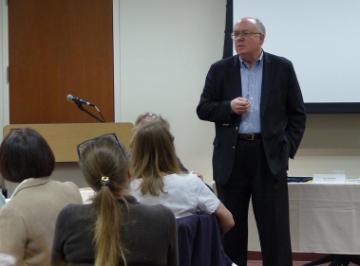
A case study on the importance of community
In an address to Bay Area government officials during the Center’s quarterly Public Sector Roundtable, Santa Clara County Supervisor Joe Simitian spoke about affordable housing in the Bay Area, using the ongoing housing dispute at Palo Alto’s Buena Vista Mobile Home Park as a case study.
Although invisible to many, Buena Vista has been a fixture of Palo Alto since the 1920s. But depending on how the litigation plays out, the mobile home park’s 400 residents (consisting of approximately 117 families and 100 children) face the very real possibility of having to leave their homes, their town, and maybe even the entire Bay Area.
When Simitian, the son of a teacher, moved to Palo Alto in 1967, he went to school with a group of kids from varying socio-economic backgrounds. He shared classes with the son of an air conditioning mechanic, the daughter of a high school custodian, and the daughter of the CEO of Hewlett-Packard.
Simitian recalled that in 1967, nobody thought it unusual that kids of modest means went to the same school as the daughter of HP’s CEO. These kids would eventually grow up to become mayors and middle school teachers; there was no limit to what they could aspire toward. Unfortunately, Simitian said, the uncertain fate of the Buena Vista Mobile Home Park vividly demonstrates that’s not the case in today’s Silicon Valley.
A few years back, Buena Vista’s owners decided they wanted to sell the mobile home property. Given the high demand for land in the Bay Area, it was reasonable to assume that a developer would buy the park and immediately replace it with more lucrative housing.
The average Buena Vista household currently makes $35,000 per year. Rent at Buena Vista is approximately $750 per month. If the residents are forced to leave as part of the sale, but wish to remain in Palo Alto, they’ll be faced with the prospect of paying three to four times that much. And the neighboring cities aren’t much cost-friendlier.
Despite the mobile home park’s invisibility, the people who live at Buena Vista do a lot of the work that Palo Alto residents have come to rely on. One female resident makes sandwiches in the deli at Molly Stone. Another works at the Four Seasons hotel in East Palo Alto. A third resident was the Rotary Club president of East Palo Alto. Simitian noted that it’s harder to “otherize” people once you know who they are and what their place in the community is.
The dispute over the closure of Buena Vista is ultimately a city issue, but Simitian felt early on that something had to be done for the 117 families. Months and months of work have resulted in public backing from local newspapers, school board members, mayors, council members, and an astoundingly successful rally in which 500 people from all parts of the economic spectrum gathered to support their fellow community members. The city of Palo Alto and the county have now set aside millions of dollars to help settle the dispute with the property owners and keep the residents of Buena Vista in their homes. Despite these impressive efforts, the opposing parties are still deadlocked in litigation.
With many questions unanswered for the residents of Buena Vista, the question posed by Simitian to the Public Sector Roundtable was, “Do we have an ethical obligation to make the South Bay a place of opportunity for all?”
In Palo Alto in particular, there’s a 3-to-1 jobs-to-housing imbalance. When new housing does pop up, it’s $4,000-a-month housing for people who work at high tech companies.
Simitian explained that this Bay Area housing problem has developed into a major traffic problem, as people who work in the Bay Area can no longer afford to live in the Bay Area. Monday through Friday thousands of people shuffle in and out of the Bay Area from remote places like Tracy and Gilroy. These people aren’t just sandwich makers and hotel concierges. They’re law enforcement officers, firefighters, and nurses. Additionally, local small businesses are having great difficulty attracting employees. It’s a dynamic that Simitian believes does not create the kind of community we’re looking for.
One member of the Public Sector Roundtable suggested that the case of the Buena Vista Mobile Home Park is an argument for the need for common good. In Simitian’s 1967 Palo Alto, everybody in the community was given a shot. Not a guarantee, but a shot. Now as the community separates into those who can afford to live within the city limits and those who cannot, that opportunity, the participant said, may very well get taken away.
Some members of the community will matter-of-factly state that not everyone gets to live in Palo Alto, or Mountain View or Los Altos. The economics simply don’t justify it, they reason. And while Simitian acknowledges that this may be true, he maintains that if we want to have the kind of community where we can go to the deli and say “Hi Sally,” we need to do the best we can for as many as we can.
So exactly who is responsible for determining the fate of our community experience? The state? The city? The market? Simitian explained that it’s often human nature to pass the buck and task someone else with solving the collective’s problem. But when a man in a crowd drops to the ground from an apparent heart attack, isn’t it everyone’s responsibility to do whatever they can to help?
Housing is usually a regional issue, but it’s typically handled city by city. Simitian pointed out that one challenge is that different cities have different visions for what their city is all about. For instance, the community members of a small, sleepy town might shy away from an initiative to bring affordable housing within its borders because of the stigma that “affordable housing” implies.
A lot has been made over the last few years about the 117 families whose community member status hangs in the balance. The question has been raised: Why these 117 families? Simitian believes that one problem with talks about affordable housing is that the people who need the housing most are never in the room when the conversation is happening. The abstract affordable housing dilemma does not often have a human dimension, but with these 117 families, he pointed out, the human dimension is undeniable. You can go to the mobile home park and actually see these people. It’s a real, immediate concern.



